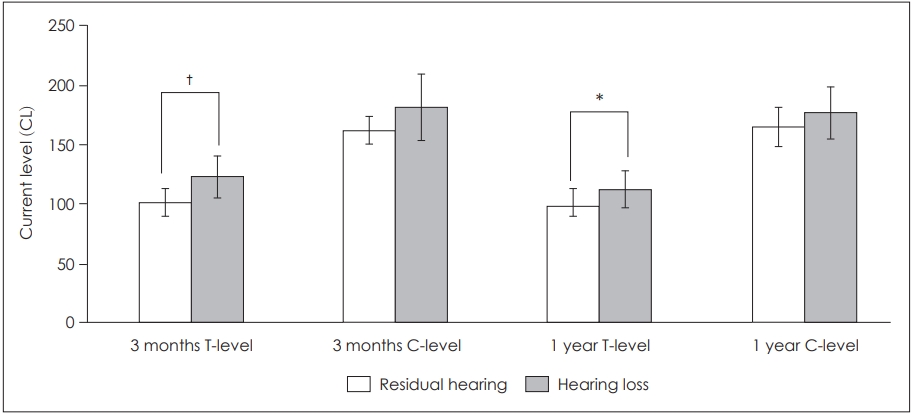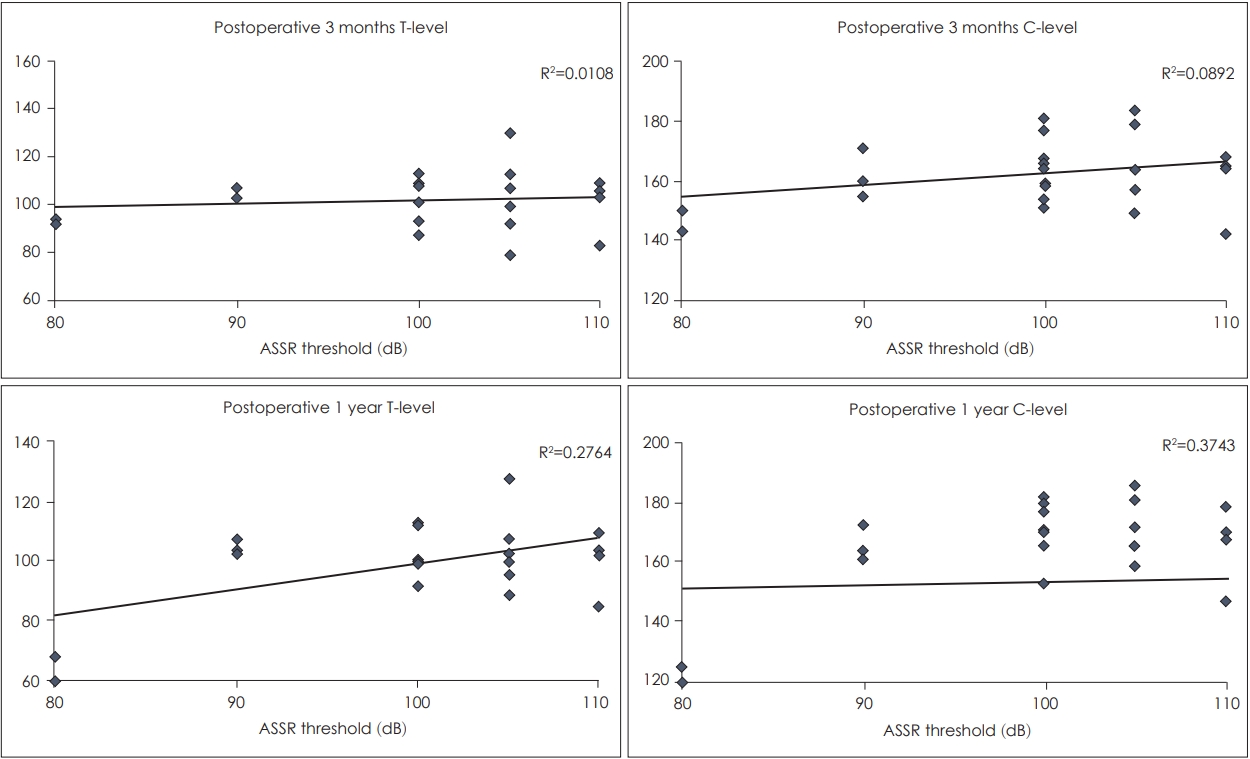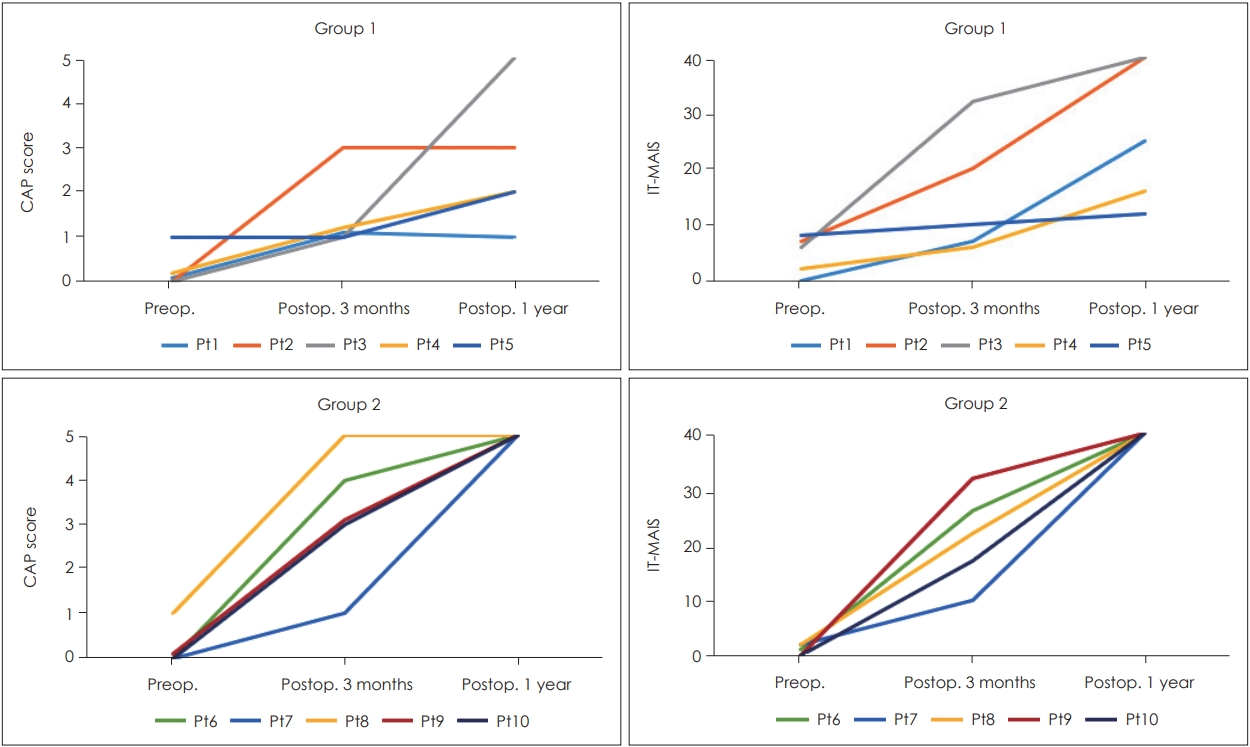1. Martini A, Bovo R, Trevisi P, Forli F, Berrettini S. Cochlear implant in children: rational, indications and cost/efficacy. Minerva Pediatr 2013;65:325ŌĆō39.

3. Chiossi JSC, Hyppolito MA. Effects of residual hearing on cochlear implant outcomes in children: a systematic-review. Int J Pediatr Otorhinolaryngol 2017;100:119ŌĆō27.


4. Cullen RD, Higgins C, Buss E, Clark M, Pillsbury HC 3rd, Buchman CA. Cochlear implantation in patients with substantial residual hearing. Laryngoscope 2004;114:2218ŌĆō23.


5. Rance G, Dowell RC, Rickards FW, Beer DE, Clark GM. Steadystate evoked potential and behavioral hearing thresholds in a group of children with absent click-evoked auditory brain stem response. Ear Hear 1998;19:48ŌĆō61.


6. Picton TW, Skinner CR, Champagne SC, Kellett AJ, Maiste AC. Potentials evoked by the sinusoidal modulation of the amplitude or frequency of a tone. J Acoust Soc Am 1987;82:165ŌĆō78.


11. Shapiro WH, Bradham TS. Cochlear implant programming. Otolaryngol Clin North Am 2012;45:111ŌĆō27.


12. Archbold S, Lutman ME, Marshall DH. Categories of auditory performance. Ann Otol Rhinol Laryngol Suppl 1995;166:312ŌĆō4.

13. Zhong Y, Xu T, Dong R, Lyu J, Liu B, Chen X. The analysis of reliability and validity of the IT-MAIS, MAIS and MUSS. Int J Pediatr Otorhinolaryngol 2017;96:106ŌĆō10.


14. Rance G, Rickards F. Prediction of hearing threshold in infants using auditory steady-state evoked potentials. J Am Acad Audiol 2002;13:236ŌĆō45.


15. Korczak P, Smart J, Delgado R, Strobel TM, Bradford C. Auditory steady-state responses. J Am Acad Audiol 2012;23:146ŌĆō70.


17. Attias J, Buller N, Rubel Y, Raveh E. Multiple auditory steady-state responses in children and adults with normal hearing, sensorineural hearing loss, or auditory neuropathy. Ann Otol Rhinol Laryngol 2006;115:268ŌĆō76.


18. Ramos HF, Grasel SS, Beck RM, Takahashi-Ramos MT, Ramos BF, de Almeida ER, et al. Evaluation of residual hearing in cochlear implants candidates using auditory steady-state response. Acta Otolaryngol 2015;135:246ŌĆō53.


19. Rance G, Rickards FW, Cohen LT, De Vidi S, Clark GM. The automated prediction of hearing thresholds in sleeping subjects using auditory steady-state evoked potentials. Ear Hear 1995;16:499ŌĆō507.


20. Yang CH, Chen HC, Hwang CF. The prediction of hearing thresholds with auditory steady-state responses for cochlear implanted children. Int J Pediatr Otorhinolaryngol 2008;72:609ŌĆō17.


21. Beck RM, Grasel SS, Ramos HF, Almeida ER, Tsuji RK, Bento RF, et al. Are auditory steady-state responses a good tool prior to pediatric cochlear implantation? Int J Pediatr Otorhinolaryngol 2015;79:1257ŌĆō62.


22. Rance G, Briggs RJ. Assessment of hearing in infants with moderate to profound impairment: the Melbourne experience with auditory steady-state evoked potential testing. Ann Otol Rhinol Laryngol Suppl 2002;189:22ŌĆō8.


23. Han D, Mo L, Liu H, Chen J, Huang L. Threshold estimation in children using auditory steady-state responses to multiple simultaneous stimuli. ORL J Otorhinolaryngol Relat Spec 2006;68:64ŌĆō8.


24. Kileny PR, Zimmerman-Phillips S, Kemink JL, Schmaltz SP. Effects of preoperative electrical stimulability and historical factors on performance with multichannel cochlear implant. Ann Otol Rhinol Laryngol 1991;100:563ŌĆō8.


25. Jeon JH, Bae MR, Song MH, Noh SH, Choi KH, Choi JY. Relationship between electrically evoked auditory brainstem response and auditory performance after cochlear implant in patients with auditory neuropathy spectrum disorder. Otol Neurotol 2013;34:1261ŌĆō6.


26. Kuo SC, Gibson WP. The influence of residual high-frequency hearing on the outcome in congenitally deaf cochlear implant recipients. Am J Otol 2000;21:657ŌĆō62.

27. Cowan RS, DelDot J, Barker EJ, Sarant JZ, Pegg P, Dettman S, et al. Speech perception results for children with implants with different levels of preoperative residual hearing. Am J Otol 1997;18(6 Suppl):S125ŌĆō6.

29. Small SA, Stapells DR. Artifactual responses when recording auditory steady-state responses. Ear Hear 2004;25:611ŌĆō23.


30. Gajadeera EA, Galvin KL, Dowell RC, Busby PA. The change in electrical stimulation levels during 24 months postimplantation for a large cohort of adults using the nucleus(R) cochlear implant. Ear Hear 2017;38:357ŌĆō67.














